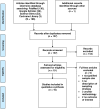The critical role of infection prevention overlooked in Ethiopia, only one-half of health-care workers had safe practice: A systematic review and meta-analysis
- PMID: 33444417
- PMCID: PMC7808611
- DOI: 10.1371/journal.pone.0245469
The critical role of infection prevention overlooked in Ethiopia, only one-half of health-care workers had safe practice: A systematic review and meta-analysis
Abstract
Background: Effective infection prevention and control measures, such as proper hand hygiene, the use of personal protective equipment, instrument processing, and safe injection practicein the healthcare facilitiesare essential elements of patient safety and lead to optimal patient outcomes. In Ethiopia, findings regarding infection prevention practices among healthcare workers have been highly variable and uncertain. This systematic review and meta-analysis estimates the pooled prevalence of safe infection prevention practices and summarizesthe associated factors among healthcare workers in Ethiopia.
Methods: PubMed, Science Direct, Google Scholar, and the Cochran library were systematically searched. We included all observational studies reporting the prevalence of safe infection prevention practices among healthcare workers in Ethiopia. Two authors independently extracted all necessary data using a standardized data extraction format. Qualitative and quantitative analyseswere employed. The Cochran Q test statistics and I2 tests were used to assess the heterogeneity of the studies. A random-effects meta-analysis model was used to estimate the pooled prevalence of safe infection prevention practice.
Results: Of the 187 articles identified through our search, 10 studies fulfilled the inclusion criteria and were included in the meta-analysis. The pooled prevalence of safe infection prevention practice in Ethiopia was 52.2% (95%CI: 40.9-63.4). The highest prevalence of safe practice was observed in Addis Ababa (capital city) 66.2% (95%CI: 60.6-71.8), followed by Amhara region 54.6% (95%CI: 51.1-58.1), and then Oromia region 48.5% (95%CI: 24.2-72.8), and the least safe practices were reported from South Nation Nationalities and People (SNNP) and Tigray regions with a pooled prevalence of 39.4% (95%CI: 13.9-64.8). In our qualitative syntheses, the odds of safe infection prevention practice were higher among healthcare workers who had good knowledge and a positive attitude towards infection prevention. Also, healthcare workers working in facilities with continuous running water supply, having infection prevention guideline, and those received training were significantly associated withhigher odds of safe infection prevention practice.
Conclusions: Infection prevention practices in Ethiopia was poor, with only half of the healthcare workers reporting safe practices. Further, the study found out that there were regional and professional variations in the prevalence of safe infection prevention practices. Therefore, the need to step-up efforts to intensify the current national infection prevention and patient safety initiative as key policy direction is strongly recommended, along with more attempts to increase healthcare worker's adherence towards infection prevention guidelines.
Conflict of interest statement
The authors have declared that no competing interests exist.
Figures



Similar articles
-
Knowledge, attitude and practice of healthcare workers on infection prevention and control in Ethiopia: A systematic review and meta-analysis.PLoS One. 2024 Sep 5;19(9):e0308348. doi: 10.1371/journal.pone.0308348. eCollection 2024. PLoS One. 2024. PMID: 39236020 Free PMC article.
-
Infection Prevention Practices and Associated Factors among Healthcare Workers in Governmental Healthcare Facilities in Addis Ababa.Ethiop J Health Sci. 2018 Mar;28(2):177-186. doi: 10.4314/ejhs.v28i2.9. Ethiop J Health Sci. 2018. PMID: 29983515 Free PMC article.
-
Tuberculosis infection control practice and associated factors among health care workers in Ethiopia: Systematic review and meta-analysis.PLoS One. 2023 Dec 12;18(12):e0295555. doi: 10.1371/journal.pone.0295555. eCollection 2023. PLoS One. 2023. PMID: 38085729 Free PMC article.
-
Adherence to infection prevention practices and associated factors among healthcare workers in Northeastern Ethiopia, following the Northern Ethiopia conflict.Front Public Health. 2024 Oct 14;12:1433115. doi: 10.3389/fpubh.2024.1433115. eCollection 2024. Front Public Health. 2024. PMID: 39469212 Free PMC article.
-
Hand Hygiene Compliance and Associated Factors among Healthcare Workers in Ethiopia: A Systematic Review and Meta-Analysis.Adv Prev Med. 2021 Dec 21;2021:7235248. doi: 10.1155/2021/7235248. eCollection 2021. Adv Prev Med. 2021. PMID: 34950518 Free PMC article. Review.
Cited by
-
Magnitude of standard precautions practices among healthcare workers in health facilities of Low and Middle Income Countries: A systematic review and meta-analysis.PLoS One. 2024 Apr 30;19(4):e0302282. doi: 10.1371/journal.pone.0302282. eCollection 2024. PLoS One. 2024. PMID: 38687766 Free PMC article.
-
Perceptions of medical waste exposure prevention among medical waste handlers in Hadiya zone, Ethiopia: a mixed-methods study using the health belief model.BMC Public Health. 2025 Mar 18;25(1):1038. doi: 10.1186/s12889-025-22247-9. BMC Public Health. 2025. PMID: 40097965 Free PMC article.
-
Health itinerary-related survival of children under-five with severe malaria or bloodstream infection, DR Congo.PLoS Negl Trop Dis. 2023 Mar 6;17(3):e0011156. doi: 10.1371/journal.pntd.0011156. eCollection 2023 Mar. PLoS Negl Trop Dis. 2023. PMID: 36877726 Free PMC article.
-
Prevalence and associated factors of thrombocytopenia among neonates in Northwest Amhara region comprehensive specialized hospitals, Ethiopia: a cross sectional study.Sci Rep. 2025 Apr 12;15(1):12610. doi: 10.1038/s41598-025-93042-0. Sci Rep. 2025. PMID: 40221464 Free PMC article.
-
Diabetic ketoacidosis treatment outcomes and its associated factors among adult patients with diabetes mellitus admitted to public hospitals in Nekemte Town, Ethiopia: a cross-sectional study.Front Clin Diabetes Healthc. 2025 Jan 14;5:1446543. doi: 10.3389/fcdhc.2024.1446543. eCollection 2024. Front Clin Diabetes Healthc. 2025. PMID: 39877829 Free PMC article.
References
-
- Allegranzi B, Storr J, Dziekan G, Leotsakos A, Donaldson L, Pittet D. The First Global Patient Safety Challenge “Clean Care is Safer Care”: from launch to current progress and achievements1. Journal of Hospital Infection. 2007. June 1;65:115–23. - PubMed
-
- WHO, Health care-associated infections FACT SHEET. 2016. Accessed date (November 13, 2020)http://www.who.int/gpsc/country_work/gpsc_ccisc_fact_sheet_en.pdf.
-
- European Centre for Disease Prevention and Control, Point prevalence survey of healthcare associated infections and antimicrobial use in European acute care hospitals. Stockholm: ECDC; 2013.
-
- CDC, Healthcare-Associated Infection Working Group of the Joint Public Policy Committee. Essentials of public reporting of healthcare- associated infections: a tool. Centers for Disease Control and Prevention (CDC). Accessed date (November 13, 2020) https://www.cste2.org/webpdfs/06107498EssentialsToolKit.pdf.
Publication types
MeSH terms
LinkOut - more resources
Full Text Sources
Other Literature Sources
Medical

